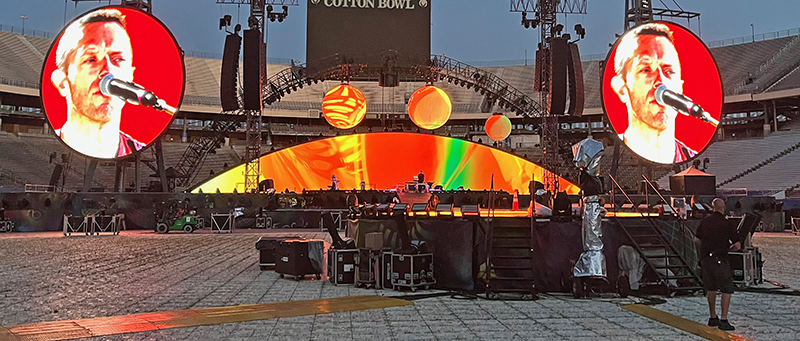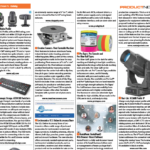
On Coldplay’s Music of the Spheres tour, there are powerful video and camera systems that provide the video team the ability to take in any signal—in any flavor—and play it back where, and whenever needed on the many playback surfaces of Production Designer Misty Buckley’s massive set. Those playback surfaces include two 14m (45.93’) circular I-Mag screens—which are used constantly throughout the show; a large arched video wall—known as the Moonrise—that is approximately 44m (144.35’) wide by 6m (19.68’) at the tallest; and four large inflatable LED video spheres suspended high above the Moonrise. The I-Mag and Moonrise LED screens are made from ROE Visual Carbon Series CB8 8mm LED panels and the LED spheres are covered in PRG LED Strip with a nominal 25mm pixel pitch. [For more details on the inflatable LED spheres, go to page 24.]
Coldplay’s video team, led by Video Designer, Leo Flint; Assistant Video Director, Luke Davies; and Video Director, Ant Barrett; knew that the production needed a powerful system with the flexibility to realize all the video, which plays a significant role throughout this performance. Other video team members included Screens Director, Josh Koffman; Video Programmer, Dan Trenchard; and Video Crew Chief Phil “Lippy” Johnston. PRG provided all of the video systems, including control, playback, LED screens, and a significant camera package not only for I-Mag and capture, but also for the crews’ monitoring system to see all over the immense main stage and two satellite stages. For PRG, Hannibal Contreras was the project manager for the camera and playback systems and Randy Schaefer handled the LED screen systems.

Real-Time Visuals and Content
For this tour, FRAY Studio used Notch to create real-time visuals, affect I-Mag looks, and provide generative effects. Video effects played a key role, with I-Mag present throughout the show. The choice of equipment was crucial as the team wanted to create a variety of looks using real-time generative effects that support the creative direction of the show. “We’re using disguise gx 2c media servers, since the gx 2cs are able to handle the type of metadata that is transmitted with this extensive of a Notch system,” says Contreras. “There’s a total of eight gx 2cs being used on this show to provide the content and we have them split up into double wide racks, for better airflow. There is a lot of demand on them with this complex show. We have an extensive crew to manage all of this. In fact, there are three video engineers on this show; one—Owen Evans, is just handling all the media servers and content devices.” In addition to FRAY Studios, other content creators included NorthHouse, Luke Halls Studio, and Impossible Brief. Head of Visual Content was Sam Seager.
Camera Systems
On the camera side, PRG provided the video team with a 10 camera 3G system using Sony HDC-4300 4K HD broadcast cameras. “It’s a 3G system, they record in 3G and send out to the screens in 3G,” explains Contreras. “Of the 10 cameras, five of them are traditionally operated, single operator type cameras, and then five additional cameras are operated on a Blackcam Systems robotic camera system. We have an additional eight Panasonic AW-UE150 PTZ cameras that are operated by the utility camera operators. Then on top of that, are eight, what most people call lipstick-type cameras—Marshall CV226s—and we have Blackmagic Micro mini 4K cameras. Those are mainly used on the drummer’s station, next to the guitarist, keyboard, and different areas that are essential shots.”
For the five cameras on the Blackcam system, three run across the stage; one stage left, one stage right. “There’s another one that’s down one side of the runway,” describes Contreras, “as well as one right in front of the B stage. In addition to those, there’s another camera that’s on the stage itself to get back shots and those hard-to-get shots, where they don’t want operators on the stage. Being low profile, these types of camera systems work perfectly for that.”
The other two system engineers—Piotr Klimcyzk and Chris Farrants—handle the camera system and the routing going to and from the stage. “They’re shading cameras on top of that, so each of them has a shading station, each of them handles five different cameras,” comments Contreras. “The senior engineer monitors all the lipstick cameras and does the color correcting on those. They set them up as they go, and once they get to show mode, they’re pretty much set and left alone.”
Key Equipment Choices
At the heart of the video system is a Grass Valley Karrera 4 M/E switcher. Contreras states, “I think one of the big things that the engineers wanted was the Ereca Stage Racer 2, which is a complete optical fiber transmission solution that supports long distance transmission. They allow you to either send audio or video down through a fiber, then reconvert back into HD, SDI, 3G, or 12G. It does comms; all these other elements. This allowed them to run a single fiber into the Stage Racers, convert the signal back into the signal flow that they needed for the stage without having to run multiple tubes of cabling for that. We have eight Ereca Stage Racers on the show; that’s made a massive difference for them to set up and provide the proper signal flows to the stage and back.”
Contreras continues, “The other elements on this tour, that are somewhat common in a general perspective, is an Evertz 96×128 3G Xlink router as the main router. There are a few sub routers including a Blackmagic 96×96 4K router as well for the signal flows that they’re sending down and back through the stage. The Karrera switcher, a 4 M/E switcher, gives the director flexibility to be able to send the signal flows in different directions, using the M/E buses. We’re using the Riedel Artist as our comm system; it’s a preference from the engineers. They prefer that Riedel system because of the flexibility that it provides for their needs.”
Complex and Flexible
Certainly, the video system for this tour was incredibly complex but as Contreras explains, it definitely needed to be so elaborate. “The engineers had worked with Coldplay on a previous tour, and they came in with some insight of what they anticipated this level of a show would be. When explaining the system to people, I tell them that you could look at this system as a mobile truck on wheels. It’s an engineering system that is out of the ordinary from what you would find on a tour. This was designed to be able to handle any flavor of signal flow that comes into the system, as well as to be able to transmit to whoever may want a particular signal. So, whether that was a composite, SDI, HD, 3G, or 4K, they are able—with this system—to provide that. This is a pretty new system approach, and it was an engineer request, so PRG worked with them to make sure we provided what they needed and what they wanted to build this robust system for this incredible show. Bringing together all the key equipment and system engineering that is on this tour was a big plus to give the video team on the show real flexibility and creative control.”


